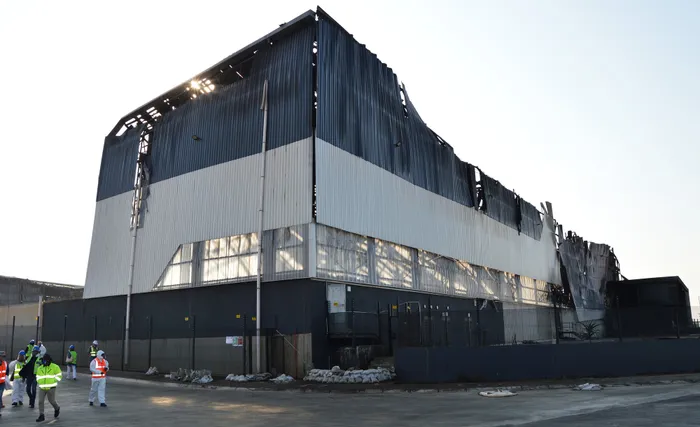Durban’s Bhopal? Unregulated storage facilities like UPL are ticking time bombs

South Africa - Durban - 10 August 2021 - Water pollution happened and the extent of the damage it has caused on marine animals and plants when a warehouse in Cornubia burnt down and the chemicals ended up contaminating the nearby river. File photo: Tumi Pakkies/African News Agency(ANA)
OPINION: How many other chemical storage facilities are there, not just in Durban, but in the rest of our country, which may be similarly inadequately licensed and flying under the radar of permitting and regulation, asks Desmond D'sa.
On July 12, the unrest in Durban caused a devastating chemical inferno when a warehouse was set alight. The warehouse was rented by Mumbai-based multinational UPL (formerly United Phosphorous Limited), an agrochemical manufacturer and marketer with an annual turnover of $5.4 billion (R80 billion).
The UPL fire raged for 10 days. Immediately residents in the surrounding areas started complaining of polluted air.
As fire fighters, unaware of the warehouse contents, fought the flames the contaminated run-off found its way into the Ohlanga River, the Umhlanga lagoon and beaches north of Durban. Dead fish and shellfish littered the beaches and surfers started to complain of rashes.
As more of the chemicals entered the river and lagoon, turning them an eerie bright blue, the eThekwini municipality was forced to shut its northern beaches. By the time the scale of the environmental and health impact was apparent, the damage had already been done.
Civil society groups, including South Durban Community Environmental Alliance and groundWork, kicked into action and engaged with local and national government to make sure environmental justice was served.
There were a number of unanswered questions like; what was the specific inventory and content stored in the facility? Were legislative and regulatory requirements met for the storage of toxic chemicals at this site?
In the immediate aftermath of the incident, UPL refused to disclose vital information on the content and quantities of its stock. This made it impossible to assess the environmental risk, and the risk faced by emergency responders and affected communities.
Without an exact inventory, we could only speculate about the chemicals running into the rivers, beaches, and polluting the air. Leaked information indicated that the warehouse contained over 5 000 tons of agri-chemicals, including approximately 1 600 pesticides, some of which were toxic to plants, fish, birds and humans.
The public information communicated by the UPL experts on how to limit exposure from smoke inhalation completely understated the health risks.
Concerned about this inadequate public advise from UPL, the civil society groups reached out to provincial authorities to offer their expertise in assisting with a transparent and urgent public health response.
Unfortunately, gripped by the fear of litigation and blame sharing, transparency and openness on information has effectively been snuffed in the handling of this disaster by the national, provincial and eThekwini authorities and the management of UPL.
Subsequently, investigative journalists at amaBhungane have uncovered the full UPL inventory. It includes suspected carcinogens, neurotoxins, chemicals that ‘may damage the unborn child’ and ‘highly caustic’ substances, including some classified as highly hazardous and banned in the EU.
These chemicals will likely cause human and environmental impacts for years, if not decades, to come. The lack of disclosure from UPL, and transparency from government in this case, threatens the open democracy that we need for environmental justice.
This disaster was not given the necessary attention and urgency it deserved by authorities from the onset. The risks for both people and the environment, however, lie not just in the release of toxic chemicals, but in a lack of adherence to regulations by UPL.
The warehouse had no environmental permits, nor had the company conducted a formal risk assessment. It also seems there was no disclosure to relevant authorities on the content stored at the warehouse, a regulatory requirement given the UPL inventory.
This renders the UPL operation as illegal. But the responsibility to monitor compliance with gazetted regulations that protect humans and the environment can be placed firmly at the doorstep of government. The scale of the disaster demands accountability.
This is not the first time Durban has had to deal with dangerous warehouse fires. The Transnet warehouse fire in 2017, and Engen explosion in 2020, are two examples. Why are we not learning from our past experiences? When is governance of chemical facilities going to be a critical priority for the state?
How many other chemical storage facilities are there, not just in Durban, but in the rest of our country, which may be similarly inadequately licensed and flying under the radar of permitting and regulation?
We need an urgent assessment of whether hazardous pesticides, chemical products and quantities are being disclosed to the correct authorities? Without storage facilities been routinely inspected by the authorities, regulatory enforcement is not possible.
Do companies have adequate fire and emergency procedures to prevent a catastrophe? Are measures in place to limit the spread of chemical fires to avert a health and environmental disaster?
There are terrible precedents that warn us against regulatory complacency. The 1984 Bhopal disaster at the Union Carbide India Limited (now DOW Chemicals) pesticide plant resulted in the immediate death of thousands of people, and affected the long term health of many others.
Investigations found that systemic violations of the laws and standard safety procedures resulted in one of the world’s worst industrial disasters. It is the South African state’s duty to keep its people safe from such potential industrial harms.
Is this going to be Durban’s Bhopal? How many other unregulated storage facilities like UPL are ticking time bombs?
* D'sa is from the South Durban Community Environmental Alliance.
** The views expressed here are not necessarily those of IOL and Independent Media.
Insider
Related Topics: